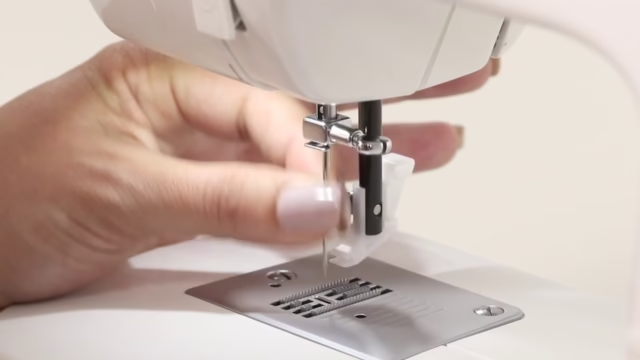Changing a needle on a Singer sewing machine is one of the most basic yet essential maintenance tasks. Whether you’re new to sewing or have been practicing for a while, it’s important to know how to change needle on Singer sewing machine properly. A dull or bent needle can ruin your fabric, skip stitches, or break threads. By learning the correct process, you ensure your sewing experience stays smooth and your machine works at its best.
This guide will walk you through when to change the needle, how to choose the right type, the steps to replace it correctly, and tips for preventing common mistakes. If you’re working on regular projects or preparing for a new one, understanding this task can make a big difference in quality and efficiency.
When Should You Change the Needle?
Many people assume the needle can be used endlessly unless it breaks. However, even if the needle looks fine, regular use can cause it to dull or slightly bend, which might not be visible. Knowing when to replace your needle can prevent many common sewing problems. Here are the main signs to look out for:
- You hear a clicking sound as the needle moves
- Your stitches are uneven or skipped
- Threads keep breaking for no apparent reason
- There’s a tugging or snagging feeling as you sew
- You’re switching to a different fabric type (denim, silk, stretch, etc.)
In general, it’s wise to change the needle after every 8–10 hours of sewing. Even if everything seems fine, a fresh needle helps maintain top performance.
Selecting the Right Needle
Before discussing how to change needle on Singer sewing machine, it’s important to know that not all needles are the same. The correct needle depends on your project and the type of fabric you’re using. Here are a few general tips:
- Use a universal needle (size 80/12 or 90/14) for general cotton or woven fabrics
- Choose a ballpoint needle for knits and stretch materials
- Select a denim needle for thick fabrics like jeans
- Use a sharp (microtex) needle for tightly woven fabrics
Also, make sure the needle you purchase is compatible with your specific Singer model. Most Singer domestic machines use flat-shank needles, but some specialized models may have different requirements. Check your manual or official Singer website for clarification.
What You’ll Need
Changing a needle doesn’t require many tools. Gather the following:
- A new, appropriate needle
- A small screwdriver (included with most Singer machines)
- Good lighting
- A safe place to keep the old needle
Some people also like to keep a small magnet on hand to pick up any dropped screws or needles.
How to Change Needle on Singer Sewing Machine
Now let’s move step-by-step through the process. You don’t need technical knowledge—just a bit of patience and careful attention.
Step 1: Turn Off the Machine
Before you begin, always switch off the power to your sewing machine. This prevents accidental injuries and ensures you can work safely. If your machine is plugged in, go ahead and unplug it as well.
Step 2: Raise the Needle
Use the handwheel on the right side of your Singer machine to manually raise the needle to its highest position. This will give you enough room to remove and insert the needle.
Step 3: Loosen the Needle Clamp Screw
Locate the needle clamp screw, which is usually on the side of the needle bar. Hold the current needle with one hand and use the small screwdriver with your other hand to turn the screw counterclockwise. Once loosened, gently pull the old needle downward and out.
Tip: Dispose of used needles carefully. Wrap them in paper or place them in a needle disposal container to avoid injury.
Step 4: Insert the New Needle
Take your new needle and identify the flat side. On most Singer machines, the flat side should face the back of the machine (away from you). Carefully insert the needle into the needle bar as far up as it will go.
Step 5: Tighten the Screw
While holding the needle in place, use your screwdriver to turn the clamp screw clockwise until it is secure. Do not overtighten, but make sure the needle is held firmly and doesn’t wiggle.
Step 6: Test the Machine
Once the new needle is in place, plug in the machine and turn it on. Sew a few practice stitches on a scrap piece of fabric to check that the needle is aligned and sewing correctly. If stitches skip or the machine struggles, double-check the position of the needle.
Common Mistakes to Avoid
Changing the needle is easy once you get used to it, but some small errors can create larger problems. Be sure to:
- Insert the needle with the flat side in the correct direction (usually facing back)
- Push the needle up completely before tightening
- Never use a bent, rusty, or wrong-type needle
- Make sure the clamp screw is not too loose
- Replace needles regularly to maintain machine health
If you continue to experience issues even after changing the needle, the problem may lie elsewhere in the machine. Re-threading or cleaning the bobbin area can sometimes help resolve these issues.
Tips for Beginners
If you’re learning how to sew or just purchased a Singer machine, the idea of maintenance might feel a little overwhelming. But understanding how to change needle on Singer sewing machine is one of the first tasks you should become confident with.
Some tips to keep in mind:
- Keep spare needles in your sewing kit so you’re never stuck
- Label your needles by type to avoid confusion later
- Change the needle before each major project
- Read your Singer machine manual for model-specific advice
Most Singer machines also come with an instruction DVD or online video access. Watching a quick demo can help reinforce what you’ve read here.
Why It Matters for Long-Term Use
Singer sewing machines are known for their quality and reliability, but like any mechanical device, they need care. Regular needle changes help extend the life of the machine and ensure better stitch quality over time. A neglected needle may break during use and potentially damage internal parts.
If you sew professionally or as a serious hobby, understanding how to change needle on Singer sewing machine becomes even more important. Fast needle swaps can save you time, improve your results, and prevent rework caused by poor stitch quality.
Troubleshooting After Changing the Needle
Sometimes even after inserting a new needle, you may run into problems. Here are a few possible reasons and solutions:
- Machine won’t sew: Check if the needle was inserted backward. Reinsert with the flat side facing the back.
- Thread keeps breaking: Try changing the thread spool or re-threading the top thread completely.
- Fabric won’t move: Make sure the presser foot is down and the feed dogs are engaged.
- Stitches skipping: Confirm that the needle is fully pushed up and tightly secured.
Most of these problems are easy to solve if you stay calm and go through the basics again.
Conclusion
Knowing how to change needle on Singer sewing machine is a simple but vital part of sewing. It keeps your projects clean, your machine in top shape, and your sewing experience smooth. You don’t need to wait until something goes wrong—changing the needle regularly as part of your routine is the best approach.
Keep a pack of fresh needles nearby, learn to recognize the signs of wear, and follow these steps with care. Before long, this task will feel just as normal as threading the machine or adjusting the stitch length.
Mastering these small steps builds the confidence that turns beginners into skilled sewers. So next time your stitches skip or thread breaks unexpectedly, you’ll know exactly what to do.







